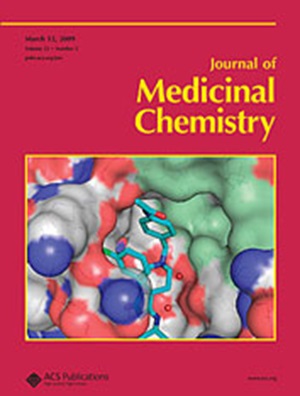Discovery of the 2,3-Dihydrobenzopyrane-4-one as a Potent FTO Inhibitor against Obesity-Related Metabolic Diseases
IF 6.8
1区 医学
Q1 CHEMISTRY, MEDICINAL
引用次数: 0
Abstract
The involvement of the fat mass and obesity-associated gene (FTO) in the development and advancement of metabolic disorders is widely recognized. However, the existing FTO inhibitor entacapone has been limited in clinical application due to its low potency and short plasma elimination half-life. Here, through drug library screening and in depth structure–activity relationship analysis, title compound 40, eriodictyol was identified as a potent FTO inhibitor, and showed good binding to FTO by surface plasmon resonance (SPR) and Microscale thermophoresis (MST) detection. The residues Arg96, Tyr108, Ser229, Asp233, and Glu234 of FTO are essential for binding. Meanwhile, eriodictyol attenuated obesity-related metabolic diseases by enhancing glucose metabolism pathways via the FTO-FOXO1-G6PC/PCK1 axis and increasing adipose tissue heat production for weight loss via the FTO-FOXO1-Ucp1 axis in vivo. Surprisingly, eriodictyol showed good pharmacokinetic properties and no obvious toxicity. These results could provide the reference for design of new FTO inhibitors against obesity-related metabolic diseases.

求助全文
约1分钟内获得全文
求助全文
来源期刊

Journal of Medicinal Chemistry
医学-医药化学
CiteScore
4.00
自引率
11.00%
发文量
804
审稿时长
1.9 months
期刊介绍:
The Journal of Medicinal Chemistry is a prestigious biweekly peer-reviewed publication that focuses on the multifaceted field of medicinal chemistry. Since its inception in 1959 as the Journal of Medicinal and Pharmaceutical Chemistry, it has evolved to become a cornerstone in the dissemination of research findings related to the design, synthesis, and development of therapeutic agents.
The Journal of Medicinal Chemistry is recognized for its significant impact in the scientific community, as evidenced by its 2022 impact factor of 7.3. This metric reflects the journal's influence and the importance of its content in shaping the future of drug discovery and development. The journal serves as a vital resource for chemists, pharmacologists, and other researchers interested in the molecular mechanisms of drug action and the optimization of therapeutic compounds.
 求助内容:
求助内容: 应助结果提醒方式:
应助结果提醒方式:


